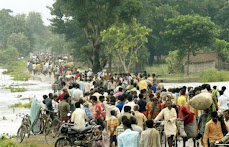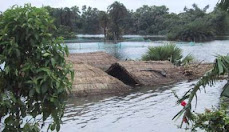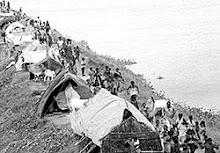
1 से 8 मार्च तक हम 15 लोग कोसी के किनारे-किनारे उसे समझने गये थे. खगड़िया, सुपौल, कमलापुर, महादेव मठ होते हुए सीतामढ़ी और वैशाली की यह यात्रा थी. कहने को तो इसे अध्ययन और फैक्ट फाईंडिंग कमेटी जैसी भारी-भरकम उपमा दे सकते हैं लेकिन असल में हम सब बाढ़ के उस अर्थशास्त्र को समझने की कोशिश कर रहे थे जो यहां की रीढ़ बन चुका है. यह अर्थशास्त्र यहां की राजनीति भी तय करता है और समाजनीति भी. बाढ़ से उबरने के नाम पर आजादी के बाद अब तक 1600 करोड़ रूपया खर्च किया जा चुका है. यह पैसा पानी में बह गया हो ऐसा नहीं है. इस पैसे ने यहां बाढ़ को बढ़ाया है. ठेकेदारों की एक चाक-चौबंद जमात पैदा की है. उन ठेकेदारों की पीठ पर राजनीतिक दलों और योजनाकारों की एक भारी-भरकम फौज पलती है. जो साल दर साल बाढ़ को बिहार की नियति बनाने का पक्का इंतजाम करती जाती है.

इन योजनाओं की ही प्रभुता है कि 1950 के दशक में जहां 25 लाख हेक्टेयर जमीन पानी में डूबी रहती थी वहीं अब 68.8 लाख हेक्टेयर जमीन पर स्थाई रूप से पानी का डेरा है. कोई भी पूछेगा कि यह कैसी योजना हुई कि दवा करते गये और मर्ज बढ़ता गया. ब्रह्मदेव चौधरी बाढ़ से भले ही तबाह हों फिर भी वे कोसी को नहीं कोसते. हमारे एक साथी ने उनसे पूछा कि अगर प्रधानमंत्री राहत योजना के तहत आपको पैसा मिले तो क्या आप बाढ़ से निपटने के लिए तटबंध बनाएंगे? ब्रह्मदेव ने समझा हम सरकार के नुमाइंदे हैं इसलिए हमें ही संबोधित करते हुए उन्होंने कहा "जितना पैसा आप तटबंध बनाने के लिए देंगे उससे ज्यादा पैसा हम आपको देते हैं लेकिन यहां कोई तटबंध मत बनाईये."
बाढ़ से उबरने के लिए जिन तटबंधों को रास्ता समझा गया वही तटबंध अब बाढ़ और विस्थापन के कारण हो गये हैं.
तटबंध का यही वह रोग है जिसे इलाज समझ लिया गया है और हर साल सरकार इसे पवित्र कर्मकाण्ड मानकर पूरा करती है. बाढ़ से निपटने की सारी योजनाएं तटबंध बनाने के नाम पर आकर सिमट जाती हैं. जो कि बाढ़ को ही बढ़ाता है. अकेले कोसी में हर साल 5 लाख 50 हजार टन से ज्यादा गाद आती है. समय के साथ पानी तो बह जाता है लेकिन गाद पीछे छूट जाती है. यह गाद उन तटबंधों के कारण वहां स्थाई डेरा डाल देती है जिसे समाधान मानकर पेश किया गया था. अब साल दो साल में वह तटबंध ही बेकार हो जाता है इसलिए हमको फिर एक नया तटबंध बनाने की जरूरत पड़ती है. और इस तरह यह एक चक्र बन जाता है.

11 मार्च को संसद में सरकार ने कहा कि बाढ़ से निपटने के लिए सरकार बागमती और महानंदा नदियों पर और तटबंध बनाने की योजना बना रही है. पता नहीं ब्रह्मदेव ने उस दिन अखबार पढ़ा या नहीं. अगर पढ़ा हो तो उन्हें वही सब हमारे मंत्री-प्रधानमंत्री को भी कहना चाहिए जो उन्होंने हमसे कहा था. शायद योजना बनानेवालों को फण्ड का कोई नया स्रोत मिल जाए. ब्रह्मदेव जैसे किसान लालू यादव के 17 साल के अयोग्य शासन से बहुत खुश हैं. ऐसा इसलिए कि लालू यादव के राज में कुछ काम नहीं हुआ. जहां कुछ न हो रहा हो वहां तटबंध भला क्यों बने? लेकिन अब सरकार की मुस्तैदी से यहां के लोग घबराए हुए हैं कि तटबंधों के कारण पलायन का नया दौर शुरू होगा.

अकेले उत्तर बिहार में 8.36 लाख हेक्टेयर जमीन सालभर पानी में डूबी है. यह कुल इलाके का 16 प्रतिशत बैठता है. लगभग 80 लाख लोग बाढ़ के सीधे प्रभाव में हैं. जाहिर सी बात है प्रभावित लोग या तो गरीब हैं या प्रभाव के कारण गरीब हो जाते हैं. ऐसे गरीब लोगों के लिए सरकार के पास कोई योजना हो ही नहीं सकती. अगर कोई योजना बने तो सबसे पहले तटबंधों पर पुनर्विचार हो. गरीबों के पास एक ही रास्ता बचता है कि वे जमीन छोड़ दें. और वे यही करते हैं. यहां से दूसरी राजनीति शुरू हो जाती है और प्राकृतिक आपदा और राजनीतिक मूर्खता के शिकार ये लोग अपने ही देश में दोयम दर्जे के नागरिक बना दिये जाते हैं. अब वापस वहां लौट नहीं सकते, शहर उन्हें अपमानित करता है. आप ही बताईये ऐसे विस्थापित लोग कहां जाएं?
Source:www.visfot.com







